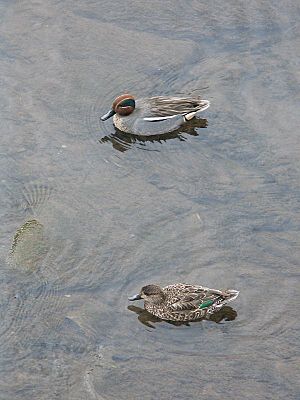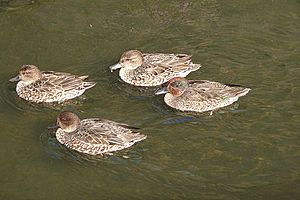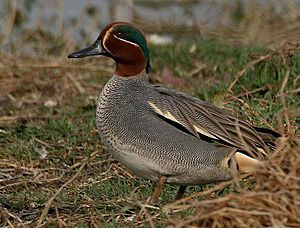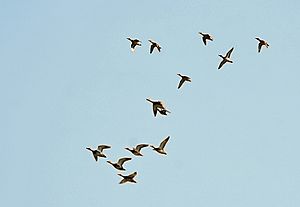Common teal facts for kids
Quick facts for kids Common teal |
|
|---|---|
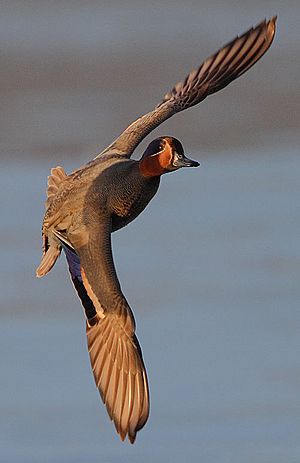 |
|
| Male in flight | |
| Scientific classification | |
| Kingdom: | |
| Class: | |
| Superorder: | |
| Order: | |
| Family: | |
| Genus: |
Anas
|
| Binomial name | |
| Anas crecca Linnaeus, 1758
|
|
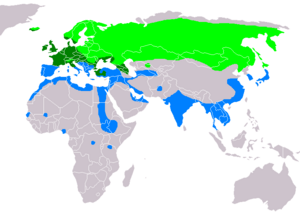 |
|
| Global range. Bright green: summer only Dark green: all year Blue: winter only |
|
The Eurasian teal or common teal (Anas crecca) is a small, common duck. It lives and breeds in cool parts of Eurasia. In winter, it flies south to warmer places. People often just call it the teal because it's the most common small dabbling duck in many areas. The bird's name also gave us the blue-green colour called teal.
These ducks love to be in groups, especially when it's not breeding season. They can form very large flocks. You can often find them in calm, wet areas like wetlands. They eat seeds and small water animals. The North American green-winged teal (A. carolinensis) is a very close relative. Some people used to think it was the same species.
Contents
What Does It Look Like?
The Eurasian teal is the smallest dabbling duck still alive. It is about 20 to 30 centimeters (8 to 12 inches) long. Males weigh about 340 grams (12 ounces), and females are a bit lighter at 320 grams (11 ounces). Their wings are 17.5 to 20.4 centimeters (6.9 to 8.0 inches) long. This gives them a wingspan of 53 to 59 centimeters (21 to 23 inches).
Male teals look grey from far away when they have their bright breeding feathers. They have a dark head, a yellowish back, and a white stripe on their sides. Their head and neck are a reddish-brown colour. They have a shiny, dark green patch shaped like a half-moon near their eye. This patch has thin yellowish-white lines around it.
Their chest is a light brown with small, round brown spots. The middle of their belly is white. The rest of their body feathers are mostly white with thin, dark lines. This makes them look medium grey. Their outer shoulder feathers are white with a black edge. These form the white stripe on their side when they are resting.
When males are not breeding, their feathers look duller. They look more like the females. Their head is dark, and their face marks are hard to see. Females are yellowish-brown, with darker wings and back. They have a dark grey-brown top of the head and a stripe through their eye. They look a lot like a tiny mallard female.
Young teals look similar to females but have stronger patterns. Baby teals are brown on top and yellow underneath. They are very tiny, weighing only about 15 grams (0.5 ounces) when they hatch.
The male's beak is dark grey. Females and young birds have beaks that are pink or yellowish at the bottom, turning dark grey at the tip. Their feet are dark grey in males and a greenish-grey or brownish-grey in females and young. Their eyes are always brown.
These ducks are quite noisy. The male makes a clear whistling sound, like "cryc" or "creelycc." It's not loud but can be heard far away. The female makes a soft "keh" or "neeh" quack.
You can tell male Eurasian teals from green-winged teals by a few things. Eurasian teals have a horizontal white stripe on their shoulder. Green-winged teals have a vertical white bar on their chest. Also, the light lines around the Eurasian teal's face patch are much clearer.
Family Tree (Taxonomy)
The Eurasian teal belongs to a group called "true teals." These are small dabbling ducks in the Anas genus. They are closely related to the mallard duck. In fact, the mallard group might have come from the true teals. The Eurasian teal, the green-winged teal, and the speckled teal (A. flavirostris) are all very similar species.
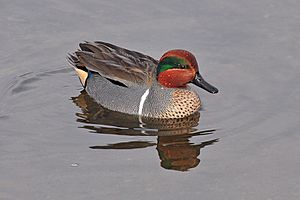
Scientists are still deciding if the Eurasian and green-winged teals are one species or two. Even though the males have very similar bright breeding feathers, they seem to be different species. This is based on how they act, how they look, and their DNA. The IUCN and BirdLife International now treat them as separate species.
Where Do They Live?

The Eurasian teal breeds across northern Eurasia. In winter, most of them fly far south to warmer places. But in milder parts of Europe, like the United Kingdom and Ireland, some stay all year. Many more birds from Siberia come to these places for winter. You can also find them all year in places like the Caucasus region and parts of Iceland.
In winter, many teals gather around the Mediterranean Sea, in Japan, and in South Asia. Other important winter spots include the Nile Valley, the Near East, and parts of East Asia and Southeast Asia. Sometimes, a few lost birds are seen in places like Greenland or the Mariana Islands. They are also seen regularly on the coasts of North America.
Overall, the Eurasian teal is not as common as its American cousin, but there are still many of them. Scientists count them mainly in winter. About 750,000 are seen around the Mediterranean and Black Seas each year. About 250,000 are in western Europe, and over 110,000 in Japan. Their numbers have gone down a little, perhaps because of pollution and wetlands being drained. But they are still doing well enough that no special action is needed, other than watching their populations and protecting their winter homes.
How Do They Behave?
These dabbling ducks love to be in groups when it's not breeding season. They form large flocks. When they fly, their fast, twisting groups look like wader birds. Even though they have short legs, they can move quite well on the ground for ducks. During breeding season, they live in calm freshwater wetlands with tall plants. These can be bogs or small lakes with lots of reeds. In winter, they often go to brackish water (a mix of fresh and salt water) or calm inlets along the seashore.
Eurasian teals usually find food by dabbling. This means they dip their heads into the water or tip their bodies upside down. Sometimes they even dive to get food. During breeding season, they mostly eat small water animals. These include crustaceans, insects and their larvae, molluscs, and worms. In winter, they mostly eat seeds from water plants and grasses. They also eat grains. During breeding season, they feed during the day. In winter, they often feed at dawn, dusk, or even at night.
They build their nests on the ground, close to water and hidden by plants. Pairs form in their winter homes and travel to the breeding grounds together, starting around March. Breeding begins a few weeks later, but not until May in the far north. The nest is a deep hollow lined with dry leaves and soft down feathers. It's built in thick plants near water. After the female starts laying eggs, the male leaves her. He goes to special lakes where he changes his feathers to his duller non-breeding look. He usually won't see his young until they meet again in the wintering areas.
A female can lay 5 to 16 eggs, but usually 8 to 11. She sits on the eggs for 21 to 23 days to keep them warm. The young ducks leave the nest soon after hatching. Their mother takes care of them for about 25 to 30 days until they can fly. The males and the females with their young usually travel to the wintering grounds separately. After their first winter, the young ducks get their adult feathers. The longest a teal has been known to live is over 27 years. This is quite old for such a small bird!
Images for kids
See also
 In Spanish: Cerceta común para niños
In Spanish: Cerceta común para niños


